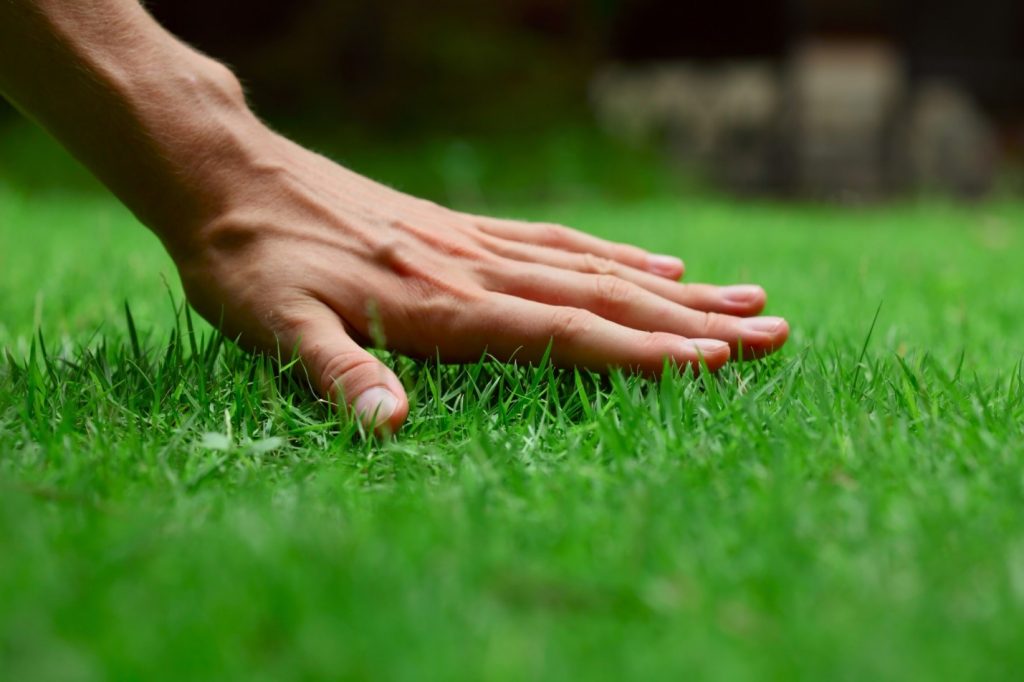Table of Contents
If we had to guess, we’d say that you aren’t a fan of mowing the lawn. No, we can’t read your mind. But let’s face it: no one enjoys lawn maintenance.
That’s especially true when all those hours you put into lawn care still leave you with dry, faded, ugly grass. So, do you want to learn how to get a green lawn without obsessive dedication and toil?
Then here’s the good news. This guide you’re reading is going to teach you all you need to know.
Note, however, that this advice won’t magically change the health and color of your lawn overnight without any effort. But it will teach you how to be more effective with your lawn care. That way, all the time that you put into this inescapable chore won’t be wasted.
Read on to learn how to get green grass in your yard the moderately easy way.

1. Water Your Lawn the Appropriate Amount
The general rule of lawn watering is to water deeply but not too frequently. Only water every other day.
The specific rule of lawn watering is to water it with 1.5 inches of water every week. Compensate (water less) when the weather is rainy.
Obviously, you’re not going to know how many inches you’re watering it offhand. So, test it.
Put empty containers all over your lawn. Then, measure the inches of water in them once the watering cycle finishes. This also helps you discover any sections of your lawn that the sprinklers are missing.
Do not overwater your lawn. When your grass is brown, it’s tempting to just water the heck out of it. But rather than nourishing your grass, this will nourish grass-destroying bugs and weeds.
2. Keep Your Mower Blade Sharp
Dull blades don’t cut grass. They punish it.
Think of it this way. When your skin is sliced with paper or a sharp blade, the cut heals quickly. When your skin is torn by something dull, it takes longer to heal.
Your grass works the same way. When your dull mower blade pummels and tears through your grass, the lawn needs extra time and energy to heal. This leaves your lawn weak and unhealthy until the next time your dull mower blade terrorizes it.
Sharpen your blades twice every mowing season and replace them as necessary.
3. Don’t Cut the Grass Too Short
Cut your grass no shorter than 3 inches. (Your mower blade should have a height setting.)
The reason for this is that the blades of the grass are just as important as the roots. It’s the green blades that provide the plant with energy through photosynthesis. This helps the roots grow deeper and stronger.
But when you scalp your grass, your whole lawn becomes weaker. Then, invasive species of weeds and bugs will overpower the grass and make a home in your lawn.
4. Keep Your Lawn Clean/Clear
Don’t leave toys, lawn chairs, and other objects on your lawn. These block the sunlight and starve your grass.
Clean up after your pets, too. Their urine and feces are toxic to your lawn.
5. Spray For Weeds Twice a Year
Weeds inevitably invade even the healthiest of lawns. The only effective way to deal with this is to spray them with lawn-safe weed killer.
Check the label carefully to make sure the product won’t kill the grass along with the weeds. Also, research any laws about using herbicides in your local area. Then, spray your whole lawn for weeds in spring and fall every year.
6. Fertilize Your Lawn Twice Per Year
Fertilizing should also be done every spring and fall. For this reason, it’s easiest to do both at the same time. In fact, there are “weed and feed” products you can buy that include both weed killer and fertilizer.
7. Aerate Your Lawn Every Fall
After enough time and foot traffic, the soil beneath your lawn gets compacted. Then, the roots of your grass can’t get the oxygen and other nutrients they need to survive. To solve this, aerate your lawn once a year each fall.
8. Have Your Soil Tested
Compaction isn’t the only thing that makes your soil unhealthy for grass. There are many other soil conditions that deprive your grass of nutrients.
You can get a soil testing kit to test it yourself. Do this at least once a year. Spring is a good time for this.
9. Spray For Pests as Needed
Sod webworms, gophers, and other destructive pests can wreak more havoc on your lawn than weeds. If you notice or suspect that such parasitic vermin are deteriorating your grass, take care of it. For instance, you might consider spraying for bugs when you spray for weeds.
10. Reseed Your Lawn as Needed
If there are serious dead patches in your lawn, reseed it. This is a simple DIY job you can learn to do by reading the product label.
11. Get Professional Help
If none of this works, or you just don’t feel like doing it, get help. Have a professional lawn service, like Franz Witte landscape contractors, examine/service your lawn.
Remember This Guide on How to Get a Green Lawn
To achieve the greenest grass on your block, remember this guide and follow these tips. Also, keep this page bookmarked for reference, just in case. Lastly, if you found this information helpful, please share this guide on how to get a green lawn with other people you know. Next, learn about the benefits of pruning services or how to choose the right type of artificial grass for your backyard. Find these tips and other awesome advice on our Home Improvement blog under the Lifestyle tab in our menu bar.



